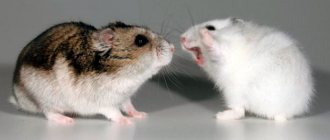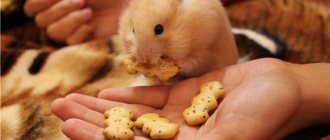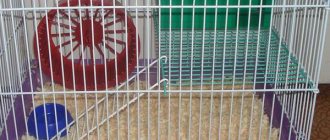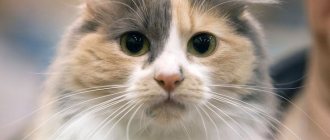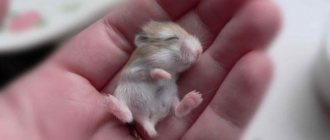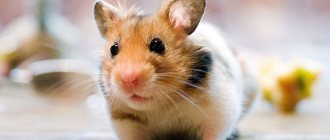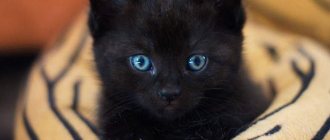- home
- Acquisition
12.04.2018
Djungarian and Syrian hamsters are the most common pets in Russia. Small furry creatures cause virtually no trouble to their owners. During the day, animals are inactive and prefer to sleep. Both breeds are friendly and will make a great friend for a child. Let's try to understand the characteristics and differences of the breeds.
External characteristics
If you place two types of hamsters next to each other, the differences will be obvious. Djungarians look like small fluffy mice without tails , gray or light - depending on the time of year. Syrians are larger, most often have a golden-red color , which does not change in winter.
Djungarians are very small and quite independent
Dzungarian breed
Djungarians are small - the length together with the tiny tail reaches 10 cm, the weight is also small - a large male weighs a maximum of 50 grams.
- The most common breeds are gray-brown in color, with a slight reddish-gold tint and always have a stripe on the back. The fur is not very long; in healthy animals it is smooth and shiny.
- By winter, the dwarfs change color - they become very light, almost white, and the stripe on the back almost disappears - it becomes weakly expressed.
Some babies change color only partially - the fur becomes light gray, almost white, but gray spots remain, and the stripe on the back remains bright.
Syrians come in several colors
Syrian breed
The largest Syrian hamster can grow up to 20 cm; such a rodent weighs 150 grams.
Reference. Syrians are called “golden” for their color - reddish or peach, differing in shades.
There are Syrians and other, more exotic colors:
- black (such hamsters are called little bear cubs);
- white - with red eyes;
- silver-gray - with a slight bluish tint;
- light peach;
- bright copper.
Over many years of breeding Syrians, many breeds with different lengths of hair have been developed - from very short to long, like Angora rabbits.
How to care for a Syrian hamster?
Where does it live in nature?
Many people are interested in where and how the Djungarian (or Sungur) hamster lives in wild natural conditions. This interest is not just caused by curiosity: after all, in order to provide the best living conditions for an animal in captivity, it is important to know what the lifestyle of its wild ancestors was like.
In the Russian expanses, this type of hamster is very common, for example, in Khakassia, in some regions of Kazakhstan, and in the steppes of Southwestern Siberia. For its habitat, this rodent, due to its food preferences, chooses semi-deserts and steppe spaces where cereal herbaceous plants grow.
Djungarian hamsters are most active at night. They live in minks, which necessarily have several entrances and holes, as well as a nesting chamber.
The life expectancy of this rodent in the wild is short - no more than two, sometimes three years. At home, it usually increases, but only slightly.
Differences between Syrian and Djungarian hamsters
Syrian hamsters are twice as large as their fellow Dzungarian hamsters, have a wide variety of colors, and do not change color depending on the time of year.
- Djungarian hamsters get along well with their fellows; they can be kept in same-sex groups of two to five animals.
- They require cages with small bars - a freedom-loving rodent will escape from a large one, squeezing between the bars, at the first opportunity. The cage should be spacious so that the kids have the opportunity to run around.
For a Syrian, a cage designed for mice or rats is suitable , but it is better to buy a special large one specifically for this type of rodent - with hammocks, a wheel and pipes in which kids like to run, and with several floors.
Syrians, unlike the Dzungarians, do not like company at all - they prefer to live alone. But if you want to have two babies, you should give preference to females from the same litter, they will get along easier together.
Djungarians are very independent, they can even bite
There are practically no differences in the content - both hamsters need a fairly spacious cage , regular change of bedding (wood filler is ideal, sawdust quickly gets wet and begins to emit an unpleasant odor). The drinking bowls for babies are no different, the food is also the same - special mixtures for rodents, some vegetables and fruits. Rodents also need to be regularly given roughage (for example, carrots) and branches of fruit trees to keep hamsters’ teeth healthy.
If you take a hamster as a baby - under two months of age - he easily gets used to your hands. But dzhungarikas are more independent in character and can bite and scratch, even if raised by their owner from birth.
Reference. Syrian babies are calmer, they almost never bite, they behave calmly in their arms, they love to crawl on a person, sleep under a hood or on their laps. By nature, Syrians are more similar to guinea pigs or domestic decorative rats - affectionate and sociable.
For those who want to breed hamsters, it makes sense to pay attention to the period when females are bearing babies. Syrians carry babies for only 16 days, Djungarian females for 18-22 days.
What breed of hamster should you choose? Depends on your circumstances
Description of the Syrian
It is similar in size to a rat, only without a long tail. It grows, on average, to 16-17 cm in length and weighs about 160-180 grams. The lifespan of Syrian hamsters ranges from two to six years and directly depends on the place of residence, living conditions and nutrition of the animal. A world record was recently recorded - a hamster lived for seven years. The coat color comes in different colors, we can say that this is the most versatile and multifaceted breed. To keep it you need a spacious cage and a running wheel, because this breed is the most energetic among its relatives. During the night they easily run five kilometers. It easily gets used to people and can be trained. He can be trained to use a litter box, recognize his name, and respond to his owner’s voice. It is better to communicate with your baby every day, otherwise he will quickly get bored and run wild. He needs to walk outside the cage several times a week, in the arms of his owner or in a special running ball. Difficulties may arise with the selection of houses and running wheels, because a large animal requires large accessories (from 18 cm in diameter). It is also necessary to remember that this species jealously guards its territory and does not allow anyone to approach it. He requires a lot of attention and care from his owner, because he cannot be satisfied by sharing a couple with him for communication. But Syrian hamsters are the most tame and quickly become attached to humans, and have good learning ability.
What breed of hamster should you choose?
If the future owner is at work all day long or often leaves for several days, it is better to get a couple of dzungariks. They will not miss their owner, they are quite independent and, if they have enough food and two drinking bowls, they can survive several days in an empty apartment.
If you want to constantly pet the hamster, hold it in your arms, comb it, play with it, the Syrian one is more suitable.
Some owners practice free range for these rodents - the hamster comes into the cage only to sleep and eat, spending all his free time in the room. When the owner returns home, the hamster runs to him, climbs up his legs and into his arms and demands attention. This behavior is not typical for Djungarian hamsters.
Djungarian hamsters are worth getting if:
- the owner is absent from the apartment all day;
- close contact with a pet is not important to him;
- I want to keep at least two animals in one cage.
Would you like a cuddly hamster?
Syrian hamsters are suitable for:
- children over three years old;
- owners who love to stroke and groom their pets - that is, they need physical contact with them;
- For those who like fluffy, colorful babies, Syrians are more elegant and evoke more vivid emotions.
Important! When choosing a hamster, you should also pay attention to such an important fact as the presence of smell. Sexually mature rodents begin to secrete sexual secretions - and the females begin to smell brightly. Among Syrians, males have a more pronounced smell.
If you change the filler in the cage regularly, the smell will be less pronounced, but it will be there.
Which hamster gets along better with children?
Let's sum it up: who is better?
The Syrian is suitable for people who crave communication with a pet. It is larger, so it is suitable even for children (less risk of your child suffocating or squeezing the body too tightly). This subspecies is more trainable and easier to handle.
Dzungarik is ideal for those who like to observe the unusual behavior of animals, but have little free time. It is harder to tame, but it requires less space and is more active. It can also be kept in a cage in pairs (just be sure to separate the female mother and her babies).
Both breeds need love and care, and both will give you a lot of positive emotions and joy. It doesn't matter which one you end up choosing. It is important that you are sincerely happy about this acquisition, then the animal will give you its love.
Which hamster is suitable for a child?
If a pet is bought for a very young child, parents need to be prepared for the fact that the parents will have to care for the rodent.
It is better for your baby to get a Syrian hamster, and buy it when it is two months old and already grown up. Such a hamster is larger, calmer, and it will be easier for the child to interact with it, hand-feed it and learn how to clean the cage and change food. Djungarians are nimble - a baby can accidentally open a cage, from which the animal will immediately escape - if there are cracks in the floor or a small opening under the door, the rodent may not be found.
If the child is already quite conscious - over five years old - then he can choose the hamster himself, depending on his own preferences. Perhaps the child will want to teach the rodent small tricks (fetching a piece of paper, jumping through a ring, running along a given path). Djungarians are suitable for such purposes - they are very trainable, more temperamental and a little smarter than their larger counterparts.
If a child wants to constantly “squeeze” the baby, stroke him, and hand feed him, it is better to choose a Syrian. They are calmer, sit well on laps and hands, and allow themselves to be stroked.
Reference. Syrian hamsters live longer than Djungarian hamsters - with good care, up to 3.5 years, while Djungarian hamsters often do not live up to two.
Whatever breed the baby chooses, the main thing is that the hamster is healthy, otherwise the joy of acquiring a friend will quickly end in tragedy and grief. What are the main signs of a healthy animal?
- the coat is smooth, shiny, not tangled;
- there are no bald spots on the skin - if there are, then this indicates an infestation with mites;
- the eyes are shiny, beautiful, without discharge;
- the animal is active, eats well, runs around the cage;
- there are no tumor-like tubercles on the body;
- the ears are not torn, there are no wounds on the body - these signs indicate the aggressiveness of the animal and its tendency to bite.
To understand whether the animal is active, it is better to go to the store or breeder in the evening, since hamsters sleep in the morning or during the day. Closer to seven o'clock, their period of activity begins - it is at this time that it is best to understand which animal is “looking” at you.
Important! If you bought a Syrian or Djungarian for your child, he needs to be examined regularly to prevent the appearance of ticks or inflammatory diseases.
Also, before purchasing, you should make sure that the child is not allergic to the animal - to fur or sexual secretions. To do this, you can ask the breeder to let the child interact with an adult animal of the species you are planning to buy. It is a very common situation that the child is not allergic to the baby, but as soon as the rodent is two or three months old, the little owner becomes intolerant.
Coat types
Through the work of breeders, four separate subspecies of Syrian hamsters have been bred. These subspecies are distinguished by the following types of coat. The most common and common is the short-haired type. With such plush-like fur, different colors look best.
Long-haired Syrians have also been bred, another name for which is Angora. Males of this subspecies have a kind of “skirt” of long (8 to 10 cm) hair in the lower part of their body. However, the females look like ordinary Syrians, perhaps a little fluffier. In foreign pet stores, this variety is called “Teddy Bear hamster”.
Peppermint treat
Ingredients:
- 1 medium overripe banana.
- 2 chicken eggs.
- 3 tbsp. spoons of honey.
- 3 tbsp. tablespoons of liquid coconut oil (can be replaced with sunflower oil in the same amount).
- 1/2 teaspoon mint flavoring.
- 1/2 teaspoon baking powder.
- A quarter cup of carob (roasted carob powder). A small amount of cocoa can be substituted, but this is not recommended for animals. Therefore, try to find an original product.
- Oat flour.
Cooking procedure.
1. Mash the banana in a bowl.
2. Beat eggs into the resulting mass, add honey, baking powder, cinnamon and coconut (sunflower) oil.
3. Add oatmeal to the mixture to form a firm but slightly moist dough.
4. Divide the resulting volume into 2 equal parts.
5. Pour 1/4 cup of carob powder into one half, and add the same amount of flour to the second half. A hard lump should form that does not stick to your hands.
6. Roll out 2 rectangles, 9-10 mm thick.
7. Place the layers of dough on top of each other and roll along the long side. Wrap the resulting sausage in plastic wrap and put it in the refrigerator overnight.
8. Preheat the oven to 180 degrees.
9. Cover a baking sheet with parchment paper.
10. Remove the film and cut into 3-3.5 cm rounds.
11. Place on a baking sheet. During cooking, portions of dough will not increase in volume, so you can place them close to each other.
12. Bake for 10-15 minutes.
If you want to please your pet with a crunchier treat, cut the rolls into thin slices (about 1 cm), and after cooking, additionally dry them in a warm oven or even in a non-stick frying pan.
The finished product is stored for a long time in a dry place. So, by baking peppermint rolls once, you can treat your four-legged pupil with them for a long time.
Bon appetit to your dog!
I like it I don't like it
Content
Like the Djungarian hamster, the Syrian is considered a territorially intolerant animal: the cubs should be separated from their mother as soon as they are four weeks old. Once the young animals reach eight weeks of age, in order to avoid conflicts, they should not be kept with each other either.
Remaining in the burrow, these hamsters behave like active housewives, sorting and sorting through food supplies, separating those that have spoiled.
In order for the hamster to move more, it is worth installing a special wheel in the cage. Well, all types of hamsters need wooden blocks or pieces of mineral stones to grind down their teeth.
Vintage basket
Here we are dealing with a representative design in the style of modern rural fashion. Best suited for lovers of cycling or short distance travel on scooters. The basket itself is woven from flexible willow and equipped with an openwork wire lid, which prevents the cat from wanting to get out while moving. At the first glance at such a carrier, one is reminded of idyllic pictures from centuries ago, when food from the market was transported in a similar way on bicycles. The entire structure is conveniently attached to the steering wheel using leather straps and does not require much time for preparation.
The advantage of the option under consideration is, of course, its original design and originality. The downside is limited functionality. Although, if desired, the basket can be used for its intended purpose.
Price – 1,128 – 1,708 rubles.
Recommendations for owners
Campbell's dwarf hamsters have very poor vision and perception of the world around them. Cataracts are also common in older hamsters. To compensate for this deficiency, they have many glands that are located on the face, on the cheeks, behind the ears and near the rectum.
Many owners notice that hamsters can clean and groom themselves in places that are unfamiliar to them. This is done so that their scent creates a trail that will allow them to find their way back to the hole. This behavior is possible for repeated visits to places with more food. Such scent trails can persist for up to eight days.
In addition to cataracts, hamsters can develop diabetes, glaucoma and tumors (both benign and malignant). Many benign and malignant tumors can be removed surgically.
Drinking fountain
Such a device can serve not only to quench the thirst of animals, but also become an original accent in the home interior. The design consists of a water bowl, a filter, a diffuser and a drinking bowl located at the top. Additionally, it is equipped with a decorative sprinkler, especially popular with native breeds (Maine Coons, Kuril Bobtails, Siberian cats).
Continuous circulation of liquid is ensured by a mini-pump powered by a USB cable. More advanced models may contain backlighting and an indication of the level of remaining water in the tank.
Cost – 2400 rub.
How to determine gender?
Sometimes the issue of gender of acquired or born individuals is fundamentally important for breeders. In ordinary hamsters, it will be much easier to determine the sex; as for dwarf breeds, to determine the sex you need to be guided by certain external distinctive features.
- The animal must be lifted by the scruff of the neck with its belly facing you. This body position will force the hamster to spread its lower limbs.
- The task of determining sex comes down to establishing the distance between the genital organs and the anus of the individual. Females will have no fur in this area in most cases. As for sexually mature males, their stomach in this area will always be wet. This is due to the active work of the glands.
- In females, the distance will be minimal, the gland is practically not visualized. There will be two rows of nipples extending from the breast. In males, the gland will be pronounced; one can note its external resemblance to the navel. In addition, there will be a significant distance between the anus and the genitals.
Conclusion
The above signs will help you easily distinguish between breeds. If the animal does not match the basic traits, this indicates crossbreeding, which is undesirable for these breeds, as it can cause mutations in subsequent generations. But crossing allows you to achieve unique, rather interesting shades of wool.
It is important to remember that, unfortunately, both breeds have a rather short life expectancy - only three years, but proper maintenance and care will give you a pet that will delight you and give you pleasant emotions.
